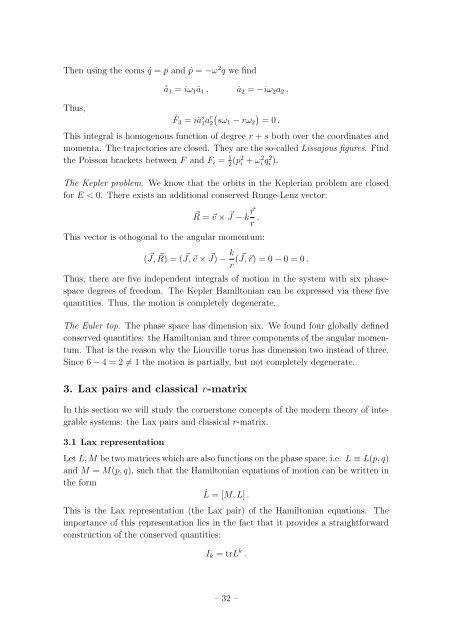Student Seminar: Classical and Quantum Integrable Systems
Student Seminar: Classical and Quantum Integrable Systems
Student Seminar: Classical and Quantum Integrable Systems
You also want an ePaper? Increase the reach of your titles
YUMPU automatically turns print PDFs into web optimized ePapers that Google loves.
Then using the eoms ˙q = p <strong>and</strong> ṗ = −ω 2 q we find<br />
Thus,<br />
˙ā 1 = iω 1 ā 1 , ȧ 2 = −iω 2 a 2 ,<br />
˙ F 3 = iā s 1a r 2(<br />
sω1 − rω 2<br />
)<br />
= 0 .<br />
This integral is homogenous function of degree r + s both over the coordinates <strong>and</strong><br />
momenta. The trajectories are closed. They are the so-called Lissajous figures. Find<br />
the Poisson brackets between F <strong>and</strong> F i = 1 2 (p2 i + ω 2 i q 2 i ).<br />
The Kepler problem. We know that the orbits in the Keplerian problem are closed<br />
for E < 0. There exists an additional conserved Runge-Lenz vector:<br />
⃗R = ⃗v × ⃗ J − k ⃗r r .<br />
This vector is othogonal to the angular momentum:<br />
( ⃗ J, ⃗ R) = ( ⃗ J, ⃗v × ⃗ J) − k r ( ⃗ J, ⃗r) = 0 − 0 = 0 .<br />
Thus, there are five independent integrals of motion in the system with six phasespace<br />
degrees of freedom. The Kepler Hamiltonian can be expressed via these five<br />
quantities. Thus, the motion is completely degenerate.<br />
The Euler top. The phase space has dimension six. We found four globally defined<br />
conserved quantities: the Hamiltonian <strong>and</strong> three components of the angular momentum.<br />
That is the reason why the Liouville torus has dimension two instead of three.<br />
Since 6 − 4 = 2 ≠ 1 the motion is partially, but not completely degenerate.<br />
3. Lax pairs <strong>and</strong> classical r-matrix<br />
In this section we will study the cornerstone concepts of the modern theory of integrable<br />
systems: the Lax pairs <strong>and</strong> classical r-matrix.<br />
3.1 Lax representation<br />
Let L, M be two matrices which are also functions on the phase space, i.e. L ≡ L(p, q)<br />
<strong>and</strong> M = M(p, q), such that the Hamiltonian equations of motion can be written in<br />
the form<br />
˙L = [M, L] .<br />
This is the Lax representation (the Lax pair) of the Hamiltonian equations. The<br />
importance of this representation lies in the fact that it provides a straightforward<br />
construction of the conserved quantities:<br />
I k = trL k .<br />
– 32 –

















